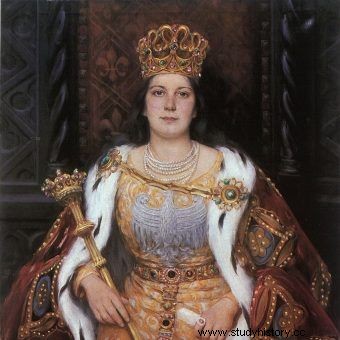And they lived happily ever after? Not at all! Many historians emphasize that in the case of the relationship between Jadwiga Andegaweńska and Władysław Jagiełło, there was no question of any happiness or even an ordinary agreement. Is that why the spouses sat at the table separately?
The thesis that Jadwiga and Jagiełło were so alien to each other that they could not even bear to eat at the same table, indeed - they even had separate kitchens, was repeated for centuries. Nineteenth-century historians wrote with enthusiasm about the dissensions in the royal marriage.

Why did Jadwiga and Jagiełło eat separately?
And in fact, it cannot be denied that Anjou and her husband ate separately:Jadwiga in the company of court ladies, clergymen, and also wives hosted by Władysław nobles (and sometimes also with more significant representatives of the Krakow bourgeoisie), Jagiełło - with courtiers, envoys, and dignitaries church and other male guests.
Medieval savoir-vivre
But was this "separation from the table" really a result of the spouses' mutual dislike? Not completely. In the Middle Ages it was a common practice in our part of Europe - Kazimierz the Great and Władysław the Short dined without their queen.
Admittedly, the Italian-French models allowed feasting together, and the Hungarian court also dined in a Western manner, so Jadwiga's parents often sat down to dinner together, but, as Wika Filipowicz comments in the book At the table with the king. How was feasted at the royal court from Jagiełło to Elizabeth II :
Jadwiga, however, did not transfer this custom to Wawel for some reason. It could have been a tribute to the Piast tradition - after all, after both grandmothers, she was Piastówna and took over the Piast legacy.
It cannot be ruled out that Jagiełło insisted on keeping separate tables, due to his family affinities he was strongly associated with the Ruthenian customs, where this custom was very much respected. Or maybe it was the decision of the Polish lords who organized the Wawel manor, who wanted to arrange it "as it used to be" or who did not like foreign news.
Which of course does not mean that Jadwiga and Jagiełło have never met in the dining room. On the occasion of particularly important state and family celebrations, as well as when receiving special guests, they shared the table.
A matter of taste
But where does the need for separate kitchens come from? Well, the main reason was very prosaic - a single kitchen simply might not be able to keep up with the nutritional needs of crowned heads and their guests. Even daily meals were often celebrated with the entire celebration, and there were even several dozen guests at the table.

Jadwiga Andegaweńska on canvas by Aleksander Augustynowicz
The second issue was the incompatible culinary tastes of Jadwiga and Jagiełło. As in the book At the table with the king reports Wika Filipowicz:
Jadwiga preferred a lighter and more exquisite cuisine of French-Italian provenance, which was the cuisine of her childhood. Jagiełło, on the other hand, preferred Lithuanian flavors, but also eagerly reached for Polish dishes. If both of them were to eat from the same plate, one would always be dissatisfied.
Jan Długosz even noted that one of Władysław's favorite delicacies - cheese dumplings - would not be eaten by his wife. The queen did not like wholemeal bread either, while her husband disliked white flour baking, which were luxurious at the time.
Which of course doesn't mean they didn't have certain "common" foods. They both did not disdain giblets, roasted poultry, cucumbers, dried fruits and nuts. They were also exceptionally unanimous on another - equally important - culinary issue. Well, as the author notes At the table with the king :
Jadwiga and Jagiełło paid great attention to the fact that the gratification for the work of the people employed in the castle was paid on time.
The Queen has always been very scrupulous about these matters. When she did not have enough cash for this purpose, she was able to pawn, for example, a gilded jug, as long as the employees did not feel disadvantaged. Her husband initially paid less attention to timely settlements with the servants, but he tried to follow her example.
The gulf between Anjou, brought up in the Western fashion, and her uncouth Lithuanian husband - although it undoubtedly existed - was therefore probably not as deep as former historians wanted to see. Or at least that's what it looked like from the kitchen.
Source:
The text is based on the book Wiki Filipowicz book At the table with the king. As was feasted at the royal court from Jagiełło to Elizabeth II , which has just been released by the Znak Horyzont publishing house.
